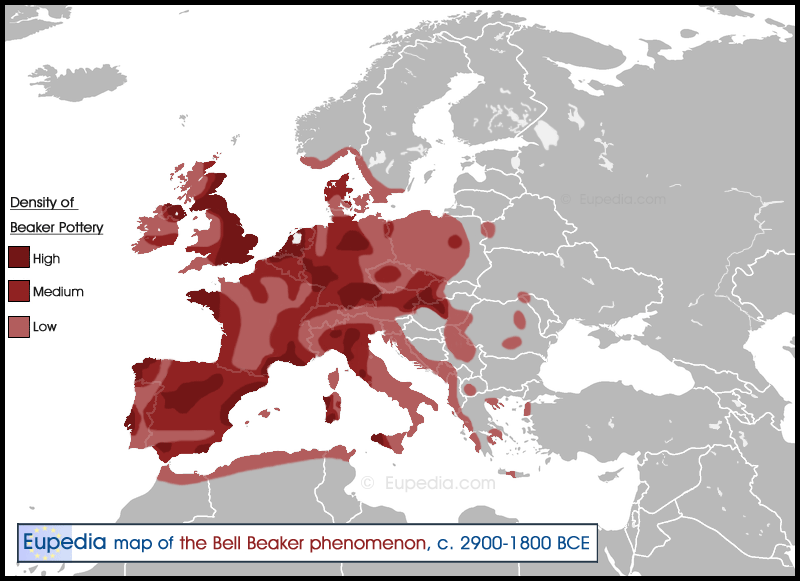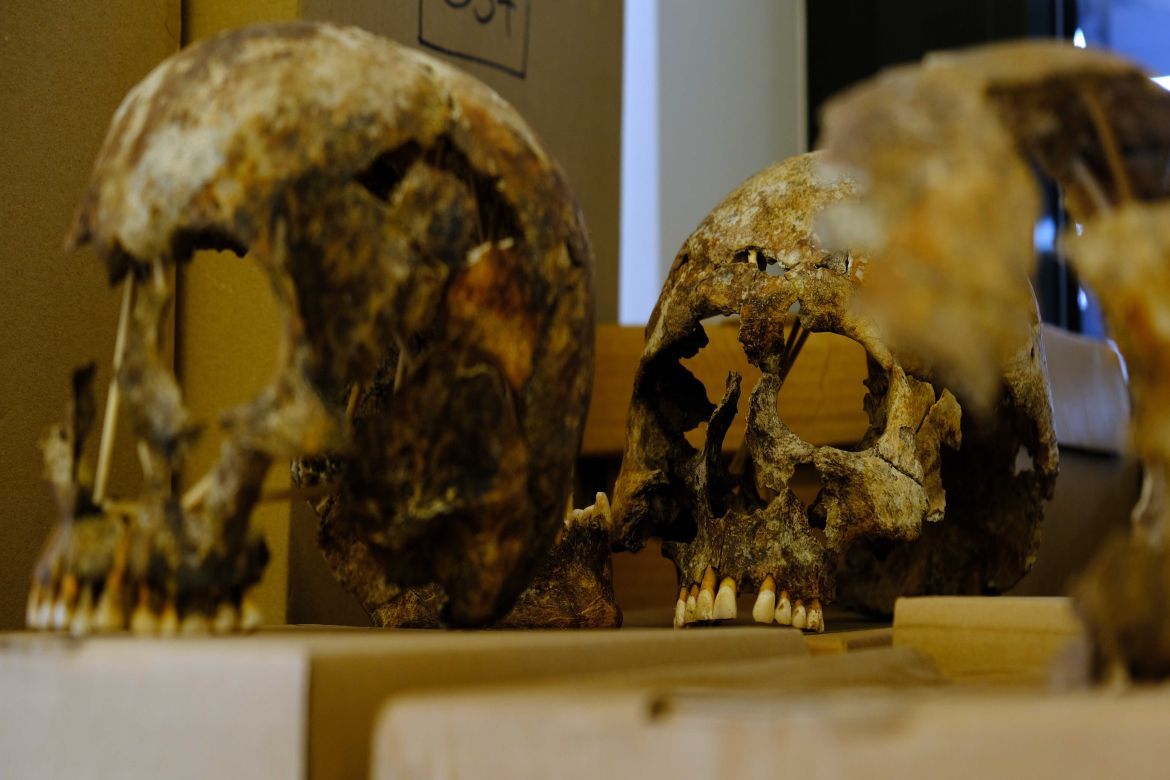Our aim is to introduce selected projects from our laboratory to the general public before publication, thus providing insight into the daily struggles and details of our work. In this small review we announce the archaeogenetic results of one of the most exciting findings of the excavations at the M7 roadworks concerning a mass grave and other associated burials at Balatonkeresztúr site.
 |
|
Fig.1.: Appearance of Bell Beaker culture in Europe (Olalde et al. 2018, source: Eupedia) |
In 2003, a mass grave of eight individuals was uncovered at Balatonkeresztúr-Réti dűlő site, belonging to ages between one and half to 45 years old found in a refuse pit. Mass graves are not rare at prehistoric sites; in fact, they were quite common from the Neolithic period to the end of the Copper Age (around 2500 BCE). However even at the early stage of research Kitti Köhler anthropologist highlighted that the anthropological features of these individuals are unknown to Prehistoric Hungary prior to the appearance of so the called Bell Beaker culture (BBC), for details, see Köhler 2006. The BBC was an archaeological culture that had been largely forgotten, but it was spread throughout major parts of Europe. Round crania as well plane nape was frequent among groups associated with BBC, which appeared with them in the Carpathian Basin at the second half of the third millennium BCE. Our laboratory, along with other Hungarian partners, is cooperating on this research. The first published results can be found here.
 |
|
Fig.2.: Mass grave of Balatonkeresztúr site (Köhler 2006) |
No artifacts were recovered from the mass grave [Fig.2.] that could define its archaeological age. Radiocarbon analyses dated it between the 18-17th centuries BCE, five hundred years after the end of BBC. At that time the so called Encrusted Pottery culture prevailed in the region characterised by single or rarely double cremation burial practices and distinctively decorated ceramics. The lack of these features in the mass grave makes its nature uncanny and incomprehensible. Multiple explanations, such as burial of migrants, outcasts, or victims of some rite or disaster, were proposed to describe this phenomenon. These theories prompted the initiation of the first genetic studies in 2017. It turned out quickly that the mass grave is hard to interpret on its own due to the lack of comparative data not only from the site but from the wide region of the era too.
To address this issue, we began collecting additional remains belonging to the Bronze Age from this site. With Viktória Kiss, leader archaeologist of the project, we gathered twelve, genetically valuable samples from the warehouse of the Rippl-Rónai Museum at Kaposvár [Fig.3.].
Fig.3.: Reconstructed skulls of the deceased from the second horizon, unfortunately centuries did not spare the remains, crania of a middle aged male at the back heavily distorted by pressure during the last 4000 years (reconstruction and photo by Dániel Gerber)
The uncovered burials span three archaeological periods (horizons) and, according to 14C dating, cover an almost 700-year timeframe, which has proven to be ideal for genetic studies.The Kisapostag or Early Encrusted Pottery culture belongs to the second horizon, when Jelena, a middle aged woman lived, who is further described here.
Preliminary results indicate an extremely exciting genetic makeup for the individuals of Kisapostag culture as it signalises recent immigration into the region. Their connection to the BBC can be demonstrated [Fig.4.], although it seems to be minor, and they rather represent a population previously unseen in Prehistoric Europe.
Fig.4.: One of the maternal lineages from Balatonkeresztúr, it shows close relationship to a BBC individual from Germany
Our task becomes more challenging from this point onward as recovering unknown genetic sources becomes a tough nut to crack. Fortunately, increasing number of archaic genomes eases the placement of certain groups, we “only” need the correct mathematical models to make assessments on origin for example. Paternal lineages of the Kisapostag culture appear to be novel in the region. However, their presence in the mass grave indicates continuity, suggesting a likely source for the individuals in the mass grave [Fig.5.]. Although the last analyses on the autosomes are still ongoing.
Fig.5.: mtDNA and Y chromosome haplogroups i.e. maternal and paternal lineages proportions at the site. Paternal lineages show great homogeneity between and within horizons.
In the meantime, withingroup relationships were inferred, although certain direction of these are hard to set, especially in cases where the time of death is uncertain. Imagine a hypothetical (but in fact common in reality!) case of two ~60 years old male laid next to each other to a single grave, where genetic analysis shows first degree relationship (about 50% of genomic – autosomal – identity). First degree relationship means parent-offspring or sibling relations, at this case it seems to be logical to assume brothers due to the same age who died at the same time, however, maternal lineages – mtDNA – are different! This seems to be easy, siblings have identical maternal and paternal lineages while father and son share only the same paternal lineage. It needs to be pointed out that maternal and paternal lineages – uniparental markers – are great help to infer kinship especially in case of huge sample numbers.
However, how to decide, who was the son and who was the father? The difference between the time of death between father and son is a few decade thus it does not help, and if no other relatives were found at the site – which is sadly a common issue – genetics cannot help further, and leave the case to anthropologists and archaeologists to define the order according to findings, grave disturbance, etc. These and such complicated situations are growing exponentially with the genetic distance between individuals, but in case of the mass grave we are lucky enough for likely having (at least nearly) identical timing of death for everyone helping to uncover kinship network much better. Accordingly, presence of two first and one second degree relationships reveals a pair of siblings, a pair of father and son as well a pair of half-siblings, although for the latter uncle-nephew cannot be excluded, but this seems to be unlikely giving the age of death. The presence of further unrelated individuals undermines the theory of blood-related family burial, and tosses the idea of some catastrophic event, as first suggested by Kitti Köhler. The research is ongoing, and the final results will serve as the backbone for Dániel Gerber's PhD dissertation. Publications and detailed descriptions are forthcoming later this year.
Archaeogenetics gives us a chance to reveal movements, origin, admixture and partly lifestyle of historic populations, but the story above shows well how hard is to get there.
Dániel Gerber – Anna Szécsényi-Nagy – Viktória Kiss





